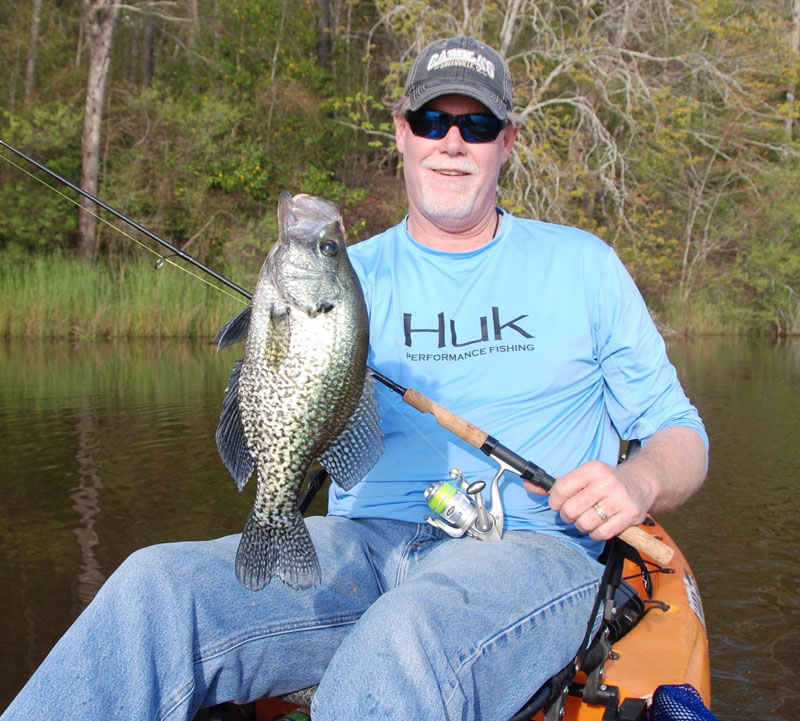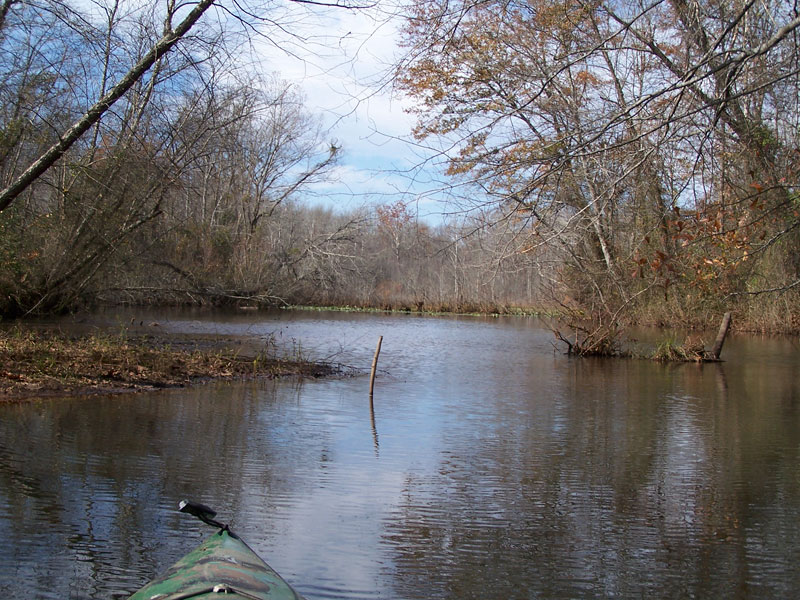
Lightweight kayaks are perfect for fishing small waters
Back in 2011, an e-mail was sent to the stable of outdoor writers who contributed to the Sportsman, asking if anyone had any experience with and would be interested in writing a column about hunting and fishing from a paddle boat. I electronically raised my hand, in large part because a few years earlier, I had traded in a 12-foot, aluminum john boat for a second-hand kayak. Why? I had a handful of hard-earned, secret fishing spots, and it was much easier to drag a lightweight plastic boat across a pasture, through the woods and down the creek bank than a box-ended aluminum one. Unknowingly, I had joined the Plastic Armada.
Each angler has his own reasons for wanting to fish or hunt from a plastic boat. A lot of these anglers only put in at public boat launches and fish the same waters as everyone else. And they catch more than their share of fish. However, those who only fish high-profile, public fishing areas are missing out on some of the best, untapped fishing to be found.
Secret fishing spots are obviously smaller bodies of water. But they can also be public waters with limited access. This includes farm ponds, oxbows, remote stretches of rivers, beaver swamps, retention ponds and even public waters off the beaten path.
Secret fishing spots are not easy to come by. Gaining access to unpressured water requires a good bit of homework. Here’s what you need to cultivate your own secret spots:
Essentials of finding honey holes
Computer. Google Earth and other satellite-imagery sites will show anyone with internet access a body of water big enough to bathe in. County GIS maps will break down those areas and tell you the registered owner of the surrounding lands. The body of water you are interested in needn’t be wholly contained by one landowner, so long as there is shoreline access. More on that later.
Permission. Years ago, permission to fish was not as big a consideration as it is today. Game wardens don’t run people off anymore. They issue citations, fines and in some cases, confiscate gear.
Permission can be in the form of a gentleman’s agreement, a signature on a card or a key to a gate. But permission is 100% mandatory.
You are more likely to obtain permission to access private land by being acquainted with the landowner than blind-calling. Rural people tend to know their neighbors. So if you know someone who owns land out in the country, search surrounding areas. An introduction from a mutual acquaintance can go a long way.
Don’t overlook public utilities
Public utilities often own tracts of land and rarely get asked permission to access their land. Find the right person and ask permission. Game wardens can be a great source of knowledge in this area. Law enforcement will know if the utility permits access to outsiders.
Wheels. As secret fishing holes rarely have easy vehicular access, you’re probably going to need a motor vehicle with some decent ground clearance and possibly 4-wheel-drive capabilities. In other situations, you may need a cart or reliable set of wheels for your kayak to traverse long roads not open to vehicular traffic or rougher ground where you’ll need to pull your boat around and through obstacles.
Responsibility. With private access comes great responsibility. The idea you want to get across to a landowner or manager is that allowing you access to his property benefits the landowner, even in some small way. You can be an extra set of trusted eyes if something is wrong or amiss, and you’re be responsible enough to close gates to protect livestock and certainly not create any burden on the landowner.
What constitutes a secret spot?
A big step to finding secret fishing spots for accessing water in a kayak is understanding riparian rights. Wikipedia defines them as: “a system for allocating water among those who possess land along its path. It has its origins in English common law. Riparian water rights exist in many jurisdictions with a common-law heritage, such as Canada, Australia, and states in the eastern United States.”
 In a nutshell, this means if you can get access to the water, via permission from an adjacent landowner or from public access, you can float and fish the water. Getting out of the boat and touching the ground, even the bottom of the waterway, may constitute trespassing.
In a nutshell, this means if you can get access to the water, via permission from an adjacent landowner or from public access, you can float and fish the water. Getting out of the boat and touching the ground, even the bottom of the waterway, may constitute trespassing.
So what are some examples of “secret spots” either with or without using riparian rights?
Farm ponds. If one or more landowners border the pond and you have permission to cross at least one parcel to access the water, you’re good.
Oxbows. Oxbows are less common in the Carolinas than other regions, but oxbows are cut-offs from large river systems. These oxbows may be open ended — tied to the river by water — or closed ended – a standalone water body where the saddle between oxbow and the main river is within the river boundary and considered public land.
Kayaks can help anglers fit anywhere
Cut-offs. A cut-off is similar to an oxbow but created when a reservoir is impounded and the backwaters or tributaries are culverted to allow a public road to parallel the water. If the access through the culvert is large enough to navigate, riparian rights may apply. If it is too small to navigate, the cut-off may be within the water boundary.
Rivers. Many flowing waters are navigable, especially in a kayak, but may flow across only private land. Bridge crossings are commonly considered public domain and may offer access points. Look for bridge crossings close enough together to float, paddle and fish from one to the other. Two boats with two vehicles is the best way to coordinate river floats unless you just want to fish around one crossing.
Retention ponds. Retention ponds, often called borrow pits, are areas near public utilities where dirt was removed to build an earthen structure. The holes filled up with water and may or may not have been stocked or were stocked via small creeks. Retention ponds can be tricky. Don’t assume public access because adjacent land is owned by a public authority. It’s best to check and get permission from the utility or an adjacent landowner.
State parks/WMAs/Game lands. These areas are open to public use but may not have launch facilities or vehicular access. They are secret because only bank anglers fish there and the areas inaccessible by land rarely gets fished.
Note: Never assume you have access to a fishing spot unless you have permission from the landowner or an agreement from a reliable source. Local game wardens can assist here.
Best Bets
NORTH CAROLINA
WHAT — American and hickory shad.
WHERE — Tar, Neuse and Roanoke rivers
HOW — Cast a brightly colored shad dart upstream and work it across the current. If the current is heavy, use double jigs, or try switching to a Sabiki rig with a 1- or 2-ounce weight on the bottom and cast the rig and drag it back slowly across the bottom.
LAUNCH — A listing of public access ramps can be found at www.ncpaws.org/ncwrcmaps/boatingaccessareas
INSIDER TIP — If using a Sabiki rig, buy those with some red in them or stick a small piece of a red plastic worm on the hook.
SOUTH CAROLINA
WHAT — Largemouth bass, crappie, bluegill.
WHERE — Farm ponds.
HOW — Rig three rods: a medium-action spinning rod with a white Senko, an ultralight rod with a chartreuse hair jig and a cork, and a 3- to 4-weight fly rod with floating line and a handful of Betts popping bugs. With these 3 rods you can land most any farm pond fish.
INSIDER TIP — Help manage private waters. Don’t completely deplete a bream bed just because you can. Take home some 14-inch largemouth bass to eat; leave the 5-pounders to grow.




Be the first to comment